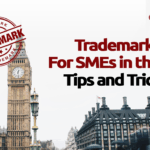
Your brand is your promise to your customer. Protecting it isn’t an expense; it’s a critical investment in your business’s future.
In the competitive landscape of small and medium-sized enterprises (SMEs), your brand is one of your most valuable assets. It distinguishes you from competitors and builds customer loyalty. For many business owners, however, the world of trademarks can seem complex and intimidating. This post cuts through the complexity to provide actionable strategies for protecting your brand effectively and efficiently.
Why Trademark Registration is a Business Essential
A registered trademark is more than just a certificate; it’s a powerful business tool. It’s crucial to understand that simply registering a company name at Companies House does not give you exclusive rights to that name in the marketplace. Only a trademark provides the legal right to use your brand for the specific goods and services you offer across the entire UK.
The strategic benefits are clear:
Legal Leverage
It provides you with a clear legal basis to take action against counterfeiters and competitors who use a confusingly similar brand.
Business Asset
A registered trademark is an intangible asset that can increase your company’s valuation, attract investment, and be licensed to create new revenue streams.
Market Position
It builds customer trust and prevents confusion, solidifying your position in your industry.
Competitive Edge
Businesses that own registered intellectual property rights consistently demonstrate higher revenue per employee and a greater likelihood of growth.
What Can and Cannot Be Registered as a Trademark
Understanding what qualifies for protection is the first step toward building a strong brand identity.
You can register a wide variety of brand elements, including words, logos, slogans, and even distinctive colours or sounds. The key principle is that the mark must be distinctive.
Conversely, you will face challenges registering terms that are purely descriptive of your goods or services. For example, “Fresh Bread” for a bakery would be rejected, as would generic statements like “We Lead the Way.” Other problematic areas include misleading terms, offensive content, and common product shapes.
A strong strategy is to choose a coined or arbitrary word, such as “Google” for search engines or “Apple” for computers. These are inherently distinctive and easier to protect. If your brand name is somewhat descriptive, consider registering it as a stylised logo to enhance its distinctiveness.
Navigating the UK Registration Process
Following a systematic approach with the UK Intellectual Property Office (UKIPO) significantly increases your chances of a smooth and successful registration.
Step 1: Conduct Comprehensive Searches
Before you invest in branding, conduct thorough searches. This means checking not only the UK trademark register but also domain names, social media platforms, and company registers. Look for not just identical names, but for similar ones that could cause consumer confusion. This critical step can prevent costly legal disputes and a forced rebrand down the line.
Step 2: Select the Correct Classes
Trademarks are registered within specific “classes” that categorise goods and services. Your protection is limited to the classes you apply for, so it’s vital to select the right ones. Consider both your current offerings and your realistic business expansion plans over the next few years.
Step 3: File Your Application
Applications are filed online through the UK IPO website. You will need to provide your details, a clear representation of your mark, and the list of goods and services covered by your chosen classes. The government fee starts at a certain level for one class, with an additional fee for each extra class.
Step 4: Examination and Publication
Once filed, the UK IPO will examine your application to ensure it meets the legal requirements. If accepted, your mark is published in an official journal for a two-month period, during which third parties can oppose the registration. If no opposition is filed, your registration will be granted, a process that typically takes three to four months.
Smart Strategies and Common Pitfalls for SMEs
Protecting your brand need not break the budget. File early to establish your legal priority date, especially before a major launch. Consider starting with a word mark, which provides the broadest protection, and adding logo versions later. Be sure to leverage the free tools and guidance offered by the UK IPO.
Be aware of common mistakes:
The Descriptive Name Trap
A name that is great for marketing can be weak for protection. If you choose one, strengthen it by registering a distinctive logo alongside it.
Incorrect Ownership
Apply to the correct legal entity (e.g., your limited company) from the start to avoid complex transfers later.
Class Selection Errors
Being too narrow leaves gaps in your protection, while being too broad wastes resources and can lead to objections.
Symbol Misuse
Use the “™” symbol for unregistered brand elements, but reserve the “®” symbol only for your officially registered marks, as its misuse is a criminal offence in the UK.
Maintaining and Enforcing Your Trademark
Registration is the beginning, not the end of your trademark journey. You must put your mark to genuine commercial use within five years of registration to keep it secure. UK trademarks last for ten years and can be renewed indefinitely, so diarize renewal deadlines.
Proactive enforcement is also key. Set up simple Google Alerts for your brand name and monitor the marketplace. If you find infringement, act promptly. Often, a well-drafted cease-and-desist letter can resolve the issue without immediate need for litigation. Always keep records of how you use your mark, such as advertisements and invoices, as evidence to defend against any future challenges.
Looking Ahead: Important Developments
The intellectual property landscape continues to evolve. Business owners should be aware that following Brexit, trademarks derived from EU registrations will soon need to demonstrate genuine use within the UK market specifically. Furthermore, always be vigilant against fraudulent emails and official-looking letters from scammers demanding payment for trademark services; always verify correspondence directly with the UK IPO.
Conclusion
The real-world consequences of overlooking trademarks can be severe. There are documented cases of small business owners facing legal opposition from large corporations after a missed renewal deadline, leading to tens of thousands of pounds in legal costs and even business closure. This underscores that proactive trademark management is not a bureaucratic task, but a core business responsibility.
Your brand represents countless hours of building customer trust and market presence. Protecting it through trademark registration is a strategic decision that safeguards your competitive advantage, enhances your company’s value, and provides peace of mind.
Your brand’s protection is a continuous journey. At eLegal Consultants, we partner with you for the long term, managing every aspect of your trademark’s lifecycle from initial registration to ongoing renewal. Let us handle the legal complexities so you can focus on growing your business. Schedule your free consultation with our experts.




